Related Research Articles

Bhārat Mātā is a national personification of India (Bharat) as a mother goddess. In the visual arts she is commonly depicted dressed in a red or saffron-coloured sari and holding a national flag; she sometimes stands on a lotus and is accompanied by a lion.

The Indian independence movement was a series of historic events with the ultimate aim of ending British rule in India. It lasted from 1857 to 1947.
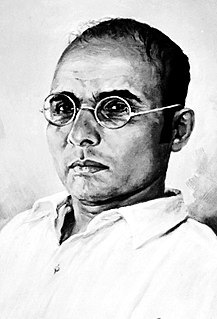
Vinayak Damodar Savarkar, known among followers by the honorific prefix Veer, was an Indian politician, activist, and writer. He developed the Hindu nationalist political ideology of Hindutva while imprisoned at Ratnagiri in 1922. He was a leading figure in the Hindu Mahasabha.
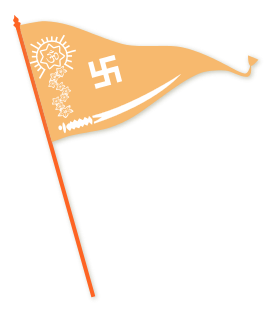
The Hindu Mahasabha is a political party in India.

The Swadeshi movement was a self-sufficiency movement that was part of the Indian independence movement and contributed to the development of Indian nationalism. Before the BML Government's decision for the partition of Bengal was made public in December 1903, there was a lot of growing discontentment among the Indians. In response the Swadeshi movement was formally started from Town Hall Calcutta on 7 August 1905 to curb foreign goods by relying on domestic production. Mahatma Gandhi described it as the soul of swaraj (self-rule). The movement took its vast size and shape after rich Indians donated money and land dedicated to Khadi and Gramodyog societies which started cloth production in every household. It also included other village industries so as to make village self-sufficient and self-reliant. The Indian National Congress used this movement as arsenal for its freedom struggle and ultimately on 15 August 1947, a hand-spun Khadi 'tricolor ashok chakra' Indian flag was unfurled at 'Princess Park' near India Gate, New Delhi by Pandit Nehru.

'Gandhism' is a body of ideas that describes the inspiration, vision, and the life work of Mahatma Gandhi. It is particularly associated with his contributions to the idea of nonviolent resistance, sometimes also called civil resistance.

Indian nationalism developed as a concept during the Indian independence movement which campaigned for independence from British rule. Indian nationalism is an instance of territorial nationalism, which is inclusive of all of the people of India, despite their diverse ethnic, linguistic and religious backgrounds. It continues to strongly influence the politics of India and reflects an opposition to the sectarian strands of Hindu nationalism and Muslim nationalism.
Manohar Malgonkar (Marathi: [12 July 1913- 14 June, 2010] [karwar district|was an Indian author of both fiction and nonfiction in the English language. He was also an army officer, a big game hunter, a civil servant, a mine owner and a farmer.
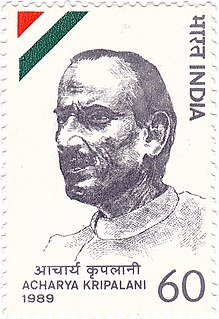
Jivatram Bhagwandas Kripalani, popularly known as Acharya Kripalani, was an Indian politician, noted particularly for holding the presidency of the Indian National Congress during the transfer of power in 1947 and the husband of Sucheta Kripalani. Kripalani was an environmentalist, mystic and independence activist who was long a Gandhian socialist, before joining the economically right wing Swatantra Party later in life

Usha Mehta was a Gandhian and freedom fighter of India. She is also remembered for organizing the Congress Radio, also called the Secret Congress Radio, an underground radio station, which functioned for few months during the Quit India Movement of 1942. In 1998, the Government of India conferred on her Padma Vibhushan, the second highest civilian award of Republic of India.
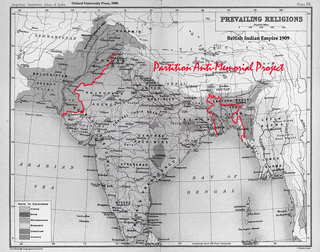
The partition of India and the associated bloody riots inspired many creative minds in India and Pakistan to create literary/cinematic depictions of this event. While some creations depicted the massacres during the refugee migration, others concentrated on the aftermath of the partition in terms of difficulties faced by the refugees in both side of the border. Even now, more than 60 years after the partition, works of fiction and films are made that relate to the events of partition.

Matangini Hazra was an Indian revolutionary who participated in the Indian independence movement until she was shot dead by the British Indian police in front of the Tamluk Police Station on 29 September 1942. She was affectionately known as Gandhi buri, Bengali for old lady Gandhi.
Gandhian economics is a school of economic thought based on the spiritual and socio-economic principles expounded by Indian leader Mahatma Gandhi. It is largely characterised by rejection of the concept of the human being as a rational actor always seeking to maximize material self-interest that underlies classical economic thinking. Where Western economic systems were based on what he called the “multiplication of wants,” Gandhi felt that this was both unsustainable and devastating to the human spirit. His model, by contrast, aimed at the fulfillment of needs – including the need for meaning and community. As a school of economics the resulting model contained elements of protectionism, nationalism, adherence to the principles and objectives of nonviolence and a rejection of class war in favor of socio-economic harmony. Gandhi's economic ideas also aim to promote spiritual development and harmony with a rejection of materialism. The term "Gandhian economics" was coined by J. C. Kumarappa, a close supporter of Gandhi.

J. C. Kumarappa was an Indian economist and a close associate of Mahatma Gandhi. A pioneer of rural economic development theories, Kumarappa is credited for developing economic theories based on Gandhism – a school of economic thought he coined "Gandhian economics."

Tiruppur Subrahmanya Avinashilingam Chettiar was an Indian lawyer, politician, freedom-fighter and Gandhian. He served as the Education Minister of Madras Presidency from 1946 to 1949 and was responsible for introducing Tamil as the medium of instruction. He is also credited with having commissioned the creation of the first Tamil encyclopedia.
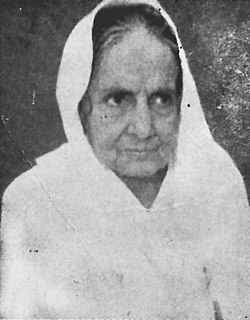
Ramadevi Choudhury(Odia: ରମାଦେବୀ ଚୌଧୁରୀ), also known as Rama Devi, was an Indian freedom fighter and a social reformer. She was called Maa (Mother) by the people of Odisha.The Ramadevi Women's University in Bhubaneswar has been named after this great personality.
Gopaldas Ambaidas Desai (1887–1951) also called Darbar Gopaldas Desai was a prince who ascended the throne of the State of Dhasa in Saurashtra and a noted Gandhian political and social activist. He is remembered as the first prince in India who gave up his principality to become a freedom fighter against the British Raj.
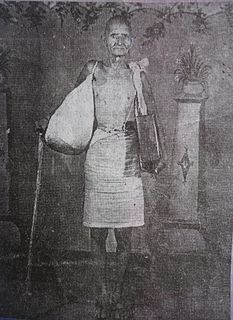
Trilochan Pokhrel was the first Indian independence activist from Sikkim. In Sikkim and North Bengal, Pokhrel is popularly called 'Bandey Pokhrel'.

Lala Achint Ram was an Indian freedom fighter, Gandhian and a member of the Indian National Congress party.
Purushottam Yashwant Deshpande, was an Indian writer in Marathi. He was awarded the Sahitya Akademi Award for Marathi language in 1962 for his philosophical work Anamikachi Chintanika.
References
- ↑ Ashok Kumar Bachchan, "A Bend in the Ganges: A Historical Novel" in Basavaraj Naikar (ed.), Indian English Literature, Volume 6, Atlantic Publishers & Distributors, 2007, p. 140.
- ↑ Malgonkar, Manohar (1964). A Bend in the Ganges. London: Hamish Hamilton, London. ISBN 9780670157259.
- ↑ Raghavendra, Dr. C. (April 2018). "Manohar Malgonkar's A Bend in the Ganges: A Deft Blend of Personal, Patriotic, Partition and Communal Affairs" (PDF). Language in India. 18. ISSN 1930-2940.